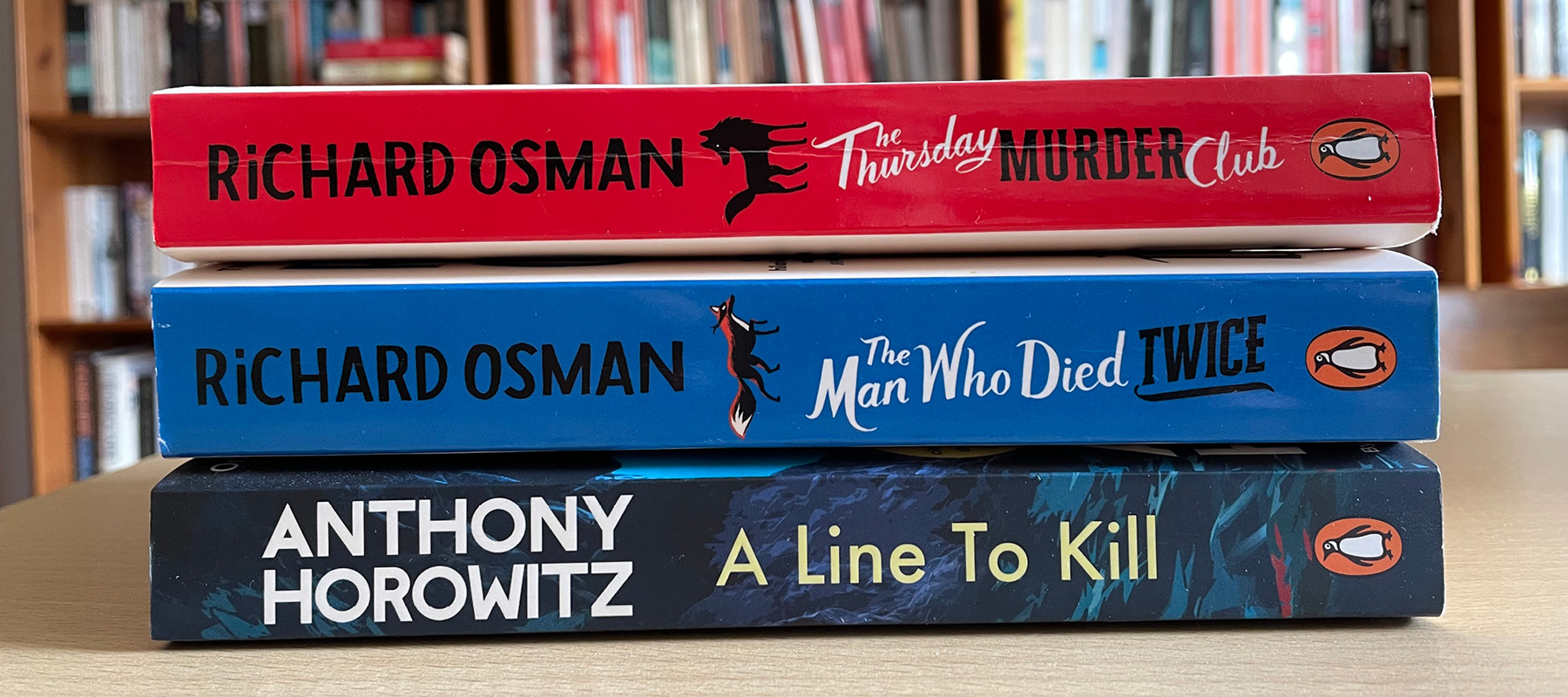The Thursday Murder Club

I am not normally a fan of ‘celebrity’ writers – or indeed celebrity much else. Football managers, for example, by which I mean former big-name players whose first or second managerial appointment is to a top club. There’s more than a whiff of unfairness in the air, a sense that their name brings with it massive breaks not available to ‘ordinary’ folk who may well be toiling in the background unnoticed for years and hoping against hope for something, anything, to happen.
There is certainly no shortage of celebrity writers, authors who are household names for something other than writing. Alan Titchmarsh, Fern Brittan, Graham Norton – to name but three, all of whom are well known from TV. Yes, I know I sound dismissive. No doubt their novels are enjoyed by millions. They might even be really good. They certainly sell well. But to what extent are the stratospheric sales – certainly of their first book – primarily a result of name recognition? That name alone is a precious commodity, enough to get the book a plum spot on one of the game-changing special-offers tables at the front of Waterstones, a headline in bookshops’ promotional emails and a place in the (shrinking) supermarket book aisles.
That’s why I shut my ears to the fanfare around The Thursday Murder Club, the first novel by Richard Osman, until I was charmed and disarmed by an interview in the paper promoting the follow-up. And yes, it is annoyingly good – as is the second in the series, The Man Who Died Twice, which I have just finished.
Annoying because… well, I have just explained why. But annoying for another reason too. The books hoodwink the reader into assuming that such an effortless read must have been equally effortless to write. It’s the same sleight-of-hand that lures us into thinking that writing for children must be – ahem – child’s play. And I do not find fiction effortless to write. In fact, I can’t do it at all. It’s frankly something of a relief, then, to read in the acknowledgements that Osman found the whole writing process bloody hard work.
You don’t need to be a master sleuth to spot the tell-tale signs of popular, page-turning crime fiction – the large, generously-spaced font, the bitesize chapters, usually ending with a mini-twist or cliffhanger, and so on. The stories are excellently structured and paced too. The plot doesn’t stand still for a moment, the short chapters offer us constantly shifting perspectives and the subplots bubble away. There’s no downtime to dwell on how ridiculous it all is (though I admit I found the pier scene in book two particularly far-fetched).
Osman’s writing is deliciously, unashamedly moreish. Opening either book is like settling down, glass in hand, in front of a roaring fire in the depths of winter. Granted, murder is the central plot device – including cold-blooded, gruesome executions – but the experience of reading The Thursday Murder Club and The Man Who Died Twice will still leave you feeling good about the world.
The setting – Coopers Chase, a luxury retirement village near to a fictional town called Fairhaven – could be somewhere in Midsomer, another fictional location populated by larger-than-life, cartoonish types and where you sense the sun is always shining. It’s that Midsomer-esque quality that helps make these books such delightful escapist fare.
Grim reality rarely intrudes. There’s no climate change, no cost-of-living crisis, no collapsing NHS. Instead, there are huge dollops of friendship, kindness and decency. The main characters all like and get on with each other. Police officers don’t childishly pull rank: Chris and Donna are best friends, even though one is a fifty-something DCI and the other a lowly constable learning the ropes before joining CID. Even the baddies have their soft side. Consider this exchange (in the second book) involving Frank Andrade Jr, a mafioso just arrived from the USA to kill the gangster Martin Lomax for ‘losing’ diamonds worth £20 million:
“Looks like I won’t have to kill you today, Martin!”
“Looks like it, Frank. How is your wife, did she get the muffins I sent?”
The trials and tribulations that come with older age can’t be completely ignored – one of the minor characters is slowly slipping away as a result of dementia, for example – and Osman certainly doesn’t shy away from gentle reflections on life’s Big Questions — family, love, loyalty, ageing, death.
But the overwhelming sense is that the members of the Thursday Murder Club are in rude health and having the time of their (long) lives. That’s perhaps another secret of the books’ appeal. Elizabeth, Ron, Joyce and Ibrahim are living out the senior years we all hope to enjoy – a time that is active, carefree, and enriched by companionship, not one impoverished by loneliness, lack of money or some unpleasant and debilitating condition or other.
And what of the four members of the Thursday Murder Club? Elizabeth apart, perhaps, there is nothing particularly remarkable about them, though in a Miss Marple kind of way their age is a sort of superpower, enabling them to ask, say and do things the police simply wouldn’t be able to.
Yes, they live secure and comfortable lives, but – to be fair – things have moved on a great deal from the “gentrified world of privilege and entitlement, of property and inherited wealth, of starched-collar formality and strict etiquette” that Agatha Christie described in her first Poirot novel a hundred or so years ago – a world I wrote about here.
We have strict gender balance, for starters. Former MI5 agent and unofficial leader Elizabeth provides the investigative skills and the knowhow when it comes to basic spycraft and dirty tricks. Joyce is a retired nurse, so handy to have at the scene of a dead body. She absorbs even the tiniest details around her but usually needs Elizabeth’s mind to fathom out the significance of what she has taken in. Regular extracts from Joyce’s gossipy diary offer a window into her world, her sometimes tense relationship with her daughter hinting at intergenerational family pressures that many readers will recognise.
Ron, meanwhile, is old school. He’s a loud, plain-speaking, West Ham-supporting ex-trade unionist who is warm and cuddly really but won’t – or doesn’t know how to – show it. Anyway, by book two he’s quietly and unobtrusively spending his nights on a camp bed by his mate Ibrahim’s hospital bed. Not, however, unobtrusively enough to escape Joyce’s notice; she later offers to drop off clean underwear, even though Ron’s manly attitude is “Honestly, no need.”
And there’s Ibrahim, the ex-psychiatrist with a sharply analytical mind. Like Ron, he is less prominent in book two. Mugged early in the proceedings, his recovery from his scars – mental as much as physical – is slow and painful. Here again is a hint at the reason for the books’ huge appeal. A subplot involving an assured and self-confident senior citizen who has the stuffing knocked out of them by some brush with mortality – an accident, a physical altercation – is one that will resonate with many of us.
Did I mention that the books are funny too – occasionally laugh-out-loud so. There are many, many great lines to enjoy. Here’s one of my favourites, a typical Joyce observation: “I’d welcome a burglar. It would be nice to have a visitor.”
And what’s not to like about writing like this, from the first book?
There had been a schism in the Cryptic Crossword Club. Colin Clemence’s weekly solving challenge had been won by Irene Dougherty for the third week running. Frank Carpenter had made an accusation of impropriety and the accusation had gained some momentum. The following day a profane crossword clue had been pinned to Colin Clemence’s door, and the moment he had solved it, all hell had broken loose.
The Thursday Murder Club is not a novel about Colin, Irene, Frank and the Cryptic Crossword Club. In fact, they are never mentioned again. But it typifies Osman’s style. One paragraph — 67 words — conveying so much information, and I don’t mean about crosswords.
The Thursday Murder Club did such a good job of reminding me of the joys of (well written) popular crime fiction that I made another impulse buy a couple of weeks later – A Line to Kill by Anthony Horowitz. I make a point of avoiding the back-cover blurbs of novels – I love setting off from page one with absolutely no idea of the direction of travel – but I am a sucker for a puff quote from someone I respect and admire. And what better recommendation than this from the marvellous Kate Mosse: “Witty, wry, clever, a fabulous detective story.” Okay, count me in.
Long before the end of the opening chapter it was clear that this was not a standalone novel, and not even the second in a series – it’s the third. Yikes. To quote Poirot: mille tonnerres! I have written often about how I always like to start any series from the very beginning. The first Poirot I read was The Mysterious Affair at Styles. My first (and so far only) Miss Marple was The Body in the Library, the first ‘proper’ one. I am also working through the Giordano Bruno novels by SJ Parris in order, starting with Heresy (I have already read one of the others, out of sequence, but I will go back to it when the time comes).
I was already familiar with the name Anthony Horowitz without quite being sure where from. The book itself reveals all – and I don’t mean on an introductory page. A Line to Kill is a bit like one of the those ‘alternate universe’ episodes (as the Americans say) from sci-fi series like Stargate-SG1 in which the characters and setting are similar to – but not quite the same as – the actual world. Or maybe it’s more like the TV series The Trip, where Steve Coogan and Rob Brydon play slightly exaggerated versions of themselves.
‘Anthony Horowitz’, then, is one of the book’s protagonists – a writer who has written a couple of true-crime books based on the work of ex-detective, private investigator and police consultant Daniel Hawthorne. Horowitz reminds us in passing that he wrote some episodes of Midsomer Murders and some (officially sanctioned) James Bond novels. Actually, he’s written much more besides, Wikipedia tells me, including plenty of stuff for television that I enjoy like Poirot and a long-forgotten detective/time-travelling mashup series from the late 90s called Crime Traveller, as well as [he adds, excitedly] two Sherlock Holmes novels.
And the verdict? Let’s just say that I now have The Word Is Murder (the first of the Hawthorne series) and Moonflower Murders in front of me, and I am hot on the trail of those Holmes novels.
Some of the content above first appeared in a regular books, TV and films blog I wrote between 2020 and 2022.

Love the write up for Richard Osman’s books. Gives you a taste of the characters, but without giving too much away. Can’t wait to start the first book now.
Glad you enjoyed it. You will really enjoy the books, I am sure! Thank you for taking the time to read my blog.